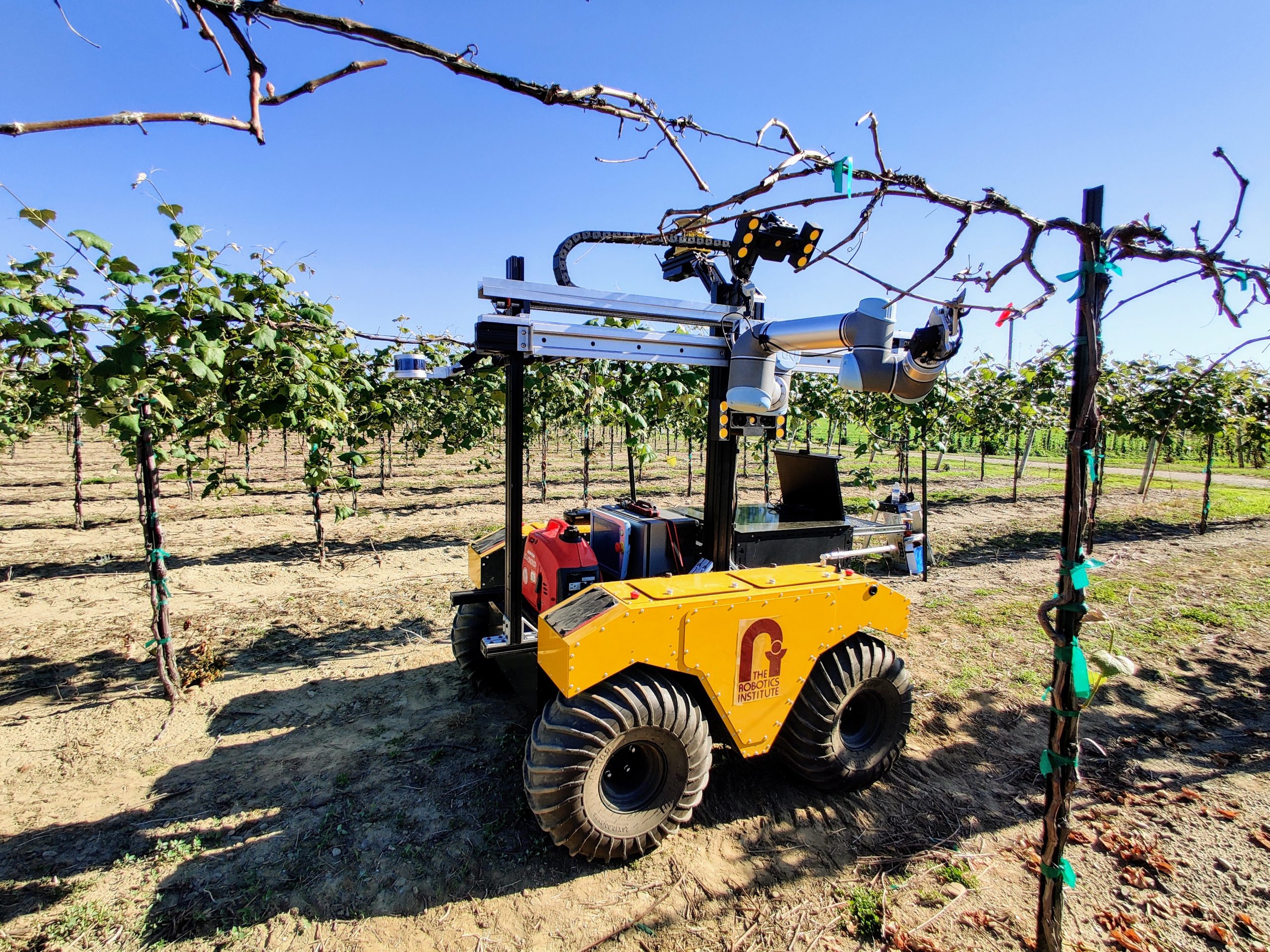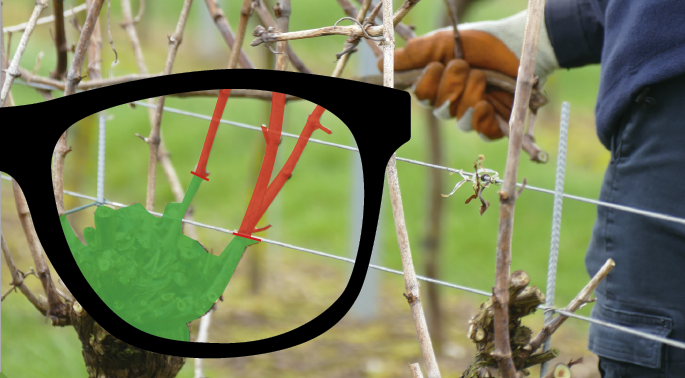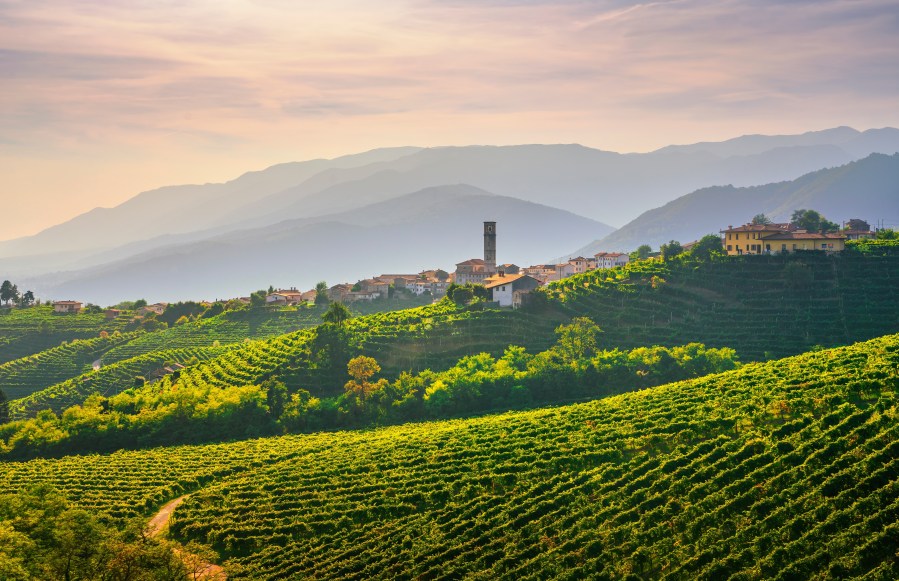Pruning is a key part of vine maintenance, helping the plant to develop healthy roots and shoots – the foundation for successful fruiting.
Pruning is a process that allows vineyard workers to individually assess the health of each vine. The removal of shoots not only helps to improve future fruit quality but can also remove infected or damaged material which could be a threat to the plant’s vigour.
Winter pruning keeps the canes required for next season’s growth and discards all others (usually) so that when the spring comes around all of the plants stored energy can be focused in the right place. Summer, or green, pruning can help to remove excess growth and any unwanted bunches that may shade or compete with the main crop for light and nutrients. Everything is focused on giving each individual vine the opportunity to perform at its best.
For the inexperienced pruner, the fear is always that they might prune too much or not enough. The received wisdom is that it is usually better to prune heavily, since it will promote good fruiting. It is also important to remember that vines are very resilient. While it is important to correct pruning errors as quickly as possible, usually they are easily resolved – either at the time or by shoot or fruit thinning later in the season if time has moved on.
An experienced pruner, with years of experience under their belt, may prune a vine in around two minutes. With potentially tens of thousands of plants in a single vineyard, this might equate to hundreds of man hours spent pruning each year.
While pruning has always been a part of vineyard life, there are a number of projects whose innovation is helping to drive technique, address the high cost of skilled labour needed and deal with the impact of climate change around the world.
Summer pruning in the Mediterranean
Italian researchers have reviewed the last two decades of research into the strategies for summer pruning – shoot positioning, thinning and trimming, leaf removal and cluster thinning. These techniques are all aimed at triggering “a dynamic seasonal change of the canopy leaf-area-to-yield ratio.” The researchers’ work paid particular attention to how these processes have been adapted because of the effects of climate change in Mediterranean areas.
They found that there was “a common need to shelter clusters against overheating and sunburn-related damages.” This had led to a more cautious approach to shoot thinning and leaf removal. When it came to cluster thinning, the research showed that it was “increasingly being depicted as an extraordinary operation that should be left to occasional occurrences of overcropping.”
It was also observed that some actions, like leaf removal, could be timed and implemented in a way that could increase or decrease the yield, and hasten or postpone ripening to a degree, as required. It is clear that growers in the Mediterranean are increasingly using summer pruning as a precision tool to help orient growth and ripening in the direction that they desire and there is a suggestion that the effects of climate change may make these tools even more important in being able to bring in a successful crop.
While here in the UK, the challenges are different, it is worth looking at the research that our European neighbours are conducting to help keep abreast of the latest understanding of method and technique.
Autonomous robotic pruning
Access to skilled labour is proving to be an issue in many parts of the world. In the United States, fewer seasonal workers were available during the winter season. This put pressure on the available workers to prune more vines in a shorter time leading to inconsistent and poor quality work. Since there were no available mechanical methods for selective pruning, a team of engineers decided to attempt to design a fully autonomous pruning system that would increase productivity and reduce the dependence on seasonal labour. They published their initial findings in 2021.
A possible drawback of the Bumblebee project was that the grapevines needed to be trained in a specific way to facilitate the use of robotic technology. The Bumblebee design was therefore tested on Concord vines in a commercial vineyard that was specifically designed and modified to “facilitate automation.” This could have an impact on how commercially viable such a robot might be for existing vineyards with established trellis systems.
On the other hand, a potential benefit of the Bumblebee robot over other solutions was that it was designed to be a multi-functional piece of technology which could perform more tasks than just pruning – like multi-sensor data collection through the season – which would give it more potential as a commercial piece of equipment.
The prototype was built using mainly off-the-shelf hardware for proof of concept, to help the engineers understand what is required to robotically prune grapevines. The challenges that they came up against included having sufficient imaging capability that would work in an outdoor environment, leading to the use of an illumination invariant camera system. This allowed consistent imaging data in any lighting conditions. Secondly, they needed to find data efficient machine learning models for processing the structure of the plants. The field study showed that vines could be accurately modelled from single side imaging.
From here, the system was able to identify pruning locations and prune 87% of canes successfully. To move the technology forward, the next steps are to improve the sensing capabilities so that the robot can assess cane health and also accurately map the vine’s size to keep the plant balanced.
A New Zealand study, published in Biosystems Engineering in 2023, also examined the modelling of grapevines for the purposes of autonomous robotic cane pruning. Their research was also inspired by the difficulties in accessing a sufficiently skilled seasonal workforce.
“The vision system is designed to generate an accurate digital 3D model of a vine with skeletonised cane structures to estimate key pruning metrics for each cane,” the researchers say.
The evaluation of the digital models that their system produced showed that 51.45% of canes were modelled entirely with an additional 35.51% missing only a single internode connection. They were satisfied that this was sufficient proof of concept for the technique to be employed as the automation of pruning continues to be developed.
Another relevant research project, 3D Skeletonization of Complex Grapevines for Robotic Pruning, was published in 2023. This American research initiative “aims to advance the robotic perception capabilities necessary for pruning in denser and more complex vine structures by extending plant skeletonization techniques.”
Read more about Bumblebee’s development

Precision viticulture
The race to develop autonomous robotic pruning machines is almost the natural evolution of the technological development within the field of pruning that has been taking place.
Precision viticulture techniques, like the use of GPS, remote sensing and GIS give vineyard managers the opportunity to create more targeted pruning strategies that are based on detailed assessments of the vineyard in real time, in the hope of optimising grape yield and quality.
Deep learning
Spur pruning has been partially mechanised for a reasonable amount of time – using cutting bars to remove the previous season’s growth or training plants to a single-wire cordon or Geneva Double Courtain, for example, to allow a more intensive level of pruning mechanisation. Having the canopy trimmed to a uniform height facilitates subsequent manual pruning. However, there are limiting factors as to where this blanket approach can be adopted. Some vineyards’ topography may not be conducive to using a cutting bar, for example.
So research is ongoing into how to simplify the manual part of the process – that which is the most time consuming and labour intensive. An important facet of modern precision viticulture is the use of deep learning that enables the vine to be analysed and the pruning regions to be identified. This technology first began with the development of an image analysis algorithm for spur pruning point identification back in 2006.
Many further studies built on that first image analysis work and now deep learning algorithms are being tested for effectiveness on different canopy management solutions. A 2023 study, published in Precision Agriculture, reported the best detection rates on visible intermediate complex spurs. A 97% detection rate was reported. The algorithm was reported to achieve “outstanding results” particularly with young vines that have “a simplified cordon and spur structure” as well as older vines that have been “subjected to effective canopy management.”
In that research, the visibility of the pruning region was the main limiting factor for the model, which is likely to be overcome by scanning the vine from multiple perspectives, although the importance of good canopy management to facilitate the introduction of agricultural robotic solutions was also highlighted. It seems that they have a thing or two to learn from the imaging techniques employed by the Bumblebee team.
Augmented reality pruning support
Another experimental development in this area has been work on the evolution of augmented reality eyewear that hopes to guide pruners with immediate and detailed information on where the vine shoots need to be cut. There is no need for training or experience to use this technology, which potentially opens up job opportunities for unskilled workers.
The 3D2cut pruning software is the brainchild of a Swiss start up. They recognised that training new workers to prune effectively is a resource-heavy endeavour – not least because that team can often have a high turnover. The software has been informed by the expertise of Vine Master Pruners, Simonit & Sirch, who are behind the start up company.
Upon wearing augmented reality glasses, the “Vine Vision System™” assesses the plant and picks up on the key features and structure of the vine. Then, the “Pruning Expert System™” uses machine learning algorithms in combination from the experience of the Master Pruners which has been programmed to identify where cuts are to be made. In turn, the vine worker sees an overlay of colour across the vine in front of them which highlights where to make cuts to the vine and indicates which section should be retained and which discarded. They describe their system as “gentle pruning.”
They claim their product has a strong sustainability angle, by removing diseased material effective pruning reduces the requirement for fungicides. Similarly, by ensuring maximum sap flow they suggest that the need for chemical fertilisers is also reduced. They also claim that effective pruning will contribute to the longevity of the vine, reducing the carbon footprint that comes with uprooting and replanting vines.
This technology has been in development since 2019 and they achieved proof of concept after a significant research and development phase in April 2022. The first patent was granted in China in December 2024. It will be interesting to see where the software system goes from here.
Read more: www.3d2cut.com

Testing long spur pruning
Recent research in Marlborough has been examining the benefits of long spur pruning over the traditional cane pruning. Since cane pruning was delivering adequate results, alternatives had not been given a huge amount of thought, but the unprecedented seasonal labour shortage in 2020, caused by the closure of New Zealand’s borders, spurred investigation into new solutions that would reduce the labour required.
The Bragato Research Institute decided to investigate a long spur pruning technique that had been pioneered by a viticulture consultant named Mark Allen. The trial took place across three vineyards comparing the typical system of pruning four canes per vine to two long spurs.
They trialled four bud spurs and five bud spurs and compared them to four bud canes as the baseline. The four bud spurs had lower yields in the first growing season, but the gap was less noticeable in the second. One set of five bud spur-pruned vines yielded significantly higher than the other options in the second season.
Fruit composition was similar across all the vines, allowing for the slight difference in yields and there was no impact on disease occurrence, except for one five bud spur vineyard having a lower incidence of Botrytis in the second season.
The study suggested that “there was no noticeable difference in wine sensory attributes across pruning treatments in both seasons.” The project is now running through its final growing season so more information will be available when the full three year trial is evaluated.
This trial was funded by the New Zealand Winegrowers Levy.

Read more about the research on the Bragato Research Institute website
The battle of the secateurs
At home, a competition is being used to help recognise skill and expertise in the field.
WineGB holds a pruning competition each year to help encourage high standards in the vineyard and to celebrate the art of pruning. In 2024, the event featured around 60 competitors. It was organised in conjunction with VineWorks and Yotes Court’s vineyard manager, Tony Purdie. The competition was sponsored by NP Seymour.
It was the first year that the event was held outside the South East of England, at the Langham Wine Estate in Dorset. There were individual and team competitions available for challengers to present their skills. In each, a minimum of five vines have to be pruned, unwanted canes pulled out and tied down within a set time. Points are awarded for speed and accuracy, with attention paid to cane selection and sap flow. Extra points are available for those who manage to prune and tie down additional vines.
The 2024 individual champion was Daniel Bojan from VineWorks, with Gusbourne taking the crown in the team event. It is heartening to see such fundamental skills being celebrated in this way. After all, without healthy vines, we would not see healthy grapes develop and while there are exciting developments in technology in the pipeline, pruning currently remains a manual and skilled endeavour that is a crucial part of vineyard life.




